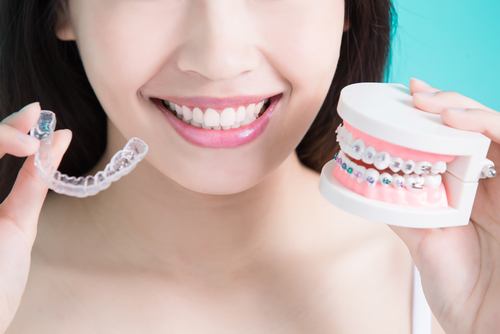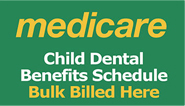- New Patient Special for $150
- Terms and Conditions Apply
- Learn More!

If you want to straighten your teeth, there are two primary options available to you: Invisalign and traditional metal braces. The type of orthodontic treatment that is best for you will depend upon the condition of your teeth. Essentially, if your teeth are severely misaligned, then Invisalign treatments might not effectively straighten your teeth. In other cases, however, traditional braces can very easily be swapped for clear, plastic Invisalign retainers. We work closely with a number of specialist orthodontists and can provide referral if necessary. In this article we enter the Invisalign vs braces debate and discuss the pros and cons of each treatment.
Invisalign treatment uses clear, plastic aligners to gently push teeth back into place. Custom aligners are manufactured following a 3D scan of the patient’s mouth. They are worn up to 22 hours per day and require consistent evaluation to ensure they are doing their job correctly. Multiple aligners are generally used over the course of treatment; as teeth begin to move into the desired position. As teeth begin to adjust, subsequent retainers will be provided in order to complete the treatment.
The most noticeable benefit of Invisalign aligners is that they are essentially invisible. Patients need not feel self-conscious wearing their aligners because they are hardly noticeable. Any photographs taken during treatment will simply show the progress of the correction process.
Furthermore, Invisalign aligners can be taken out when eating. This means there need not be any dietary changes while undergoing treatment, which isn’t the case with braces. Aligners may also be removed to brush and floss teeth. Despite this, aligners should be worn for 20-22 hours per week.
Invisalign treatment requires fewer dental consultations than braces treatment does. Aligners should be changed at the request of your dentist, but there is no need to visit the dentist for adjustments.
Finally, Invisalign treatments are generally more comfortable than braces. They can be initially uncomfortable, however because the aligners are custom-fitted, there is less propensity for cuts to appear on the inside of cheeks and the gums.
Invisalign aligners require discipline in order to work. Aligners must be worn 20-22 hours per day and only taken out to eat or to brush or floss teeth. If patients forget to wear their aligners after eating or cleaning their teeth then the progress of treatment will slow down considerably. Similarly, patients must take care not to lose their aligners, which can be difficult when eating in a public place. A carry case can be used to safely store aligners when Invisalign patients are eating or brushing outside of the home.
Braces are made of metal and are attached to the front of teeth. Metal wires and rubber bands are attached to the brackets to slowly adjust teeth into their correct positions. Recent orthodontic innovation means ceramic and behind-the-teeth braces are now available. These braces function in the same fashion as traditional, metal braces, but are less easily noticed.
Braces are suitable for any situation where teeth need to be straightened, regardless of the complexity of the condition. Braces are the most powerful treatment method for correcting the position of teeth because they can apply far more force than Invisalign aligners. In addition to this, braces treatment tends to work a lot faster than Invisalign treatment.
In contrast to this, traditional, metal braces are rather noticeable and some patients find their aesthetic unappealing. Also, brushing and flossing with braces can be a little difficult. If patients do not brush properly, they risk plaque building up around the braces which can lead to stains and decay. When wearing braces, some care needs to be taken when choosing a diet. Hard or sticky foods can cause the wire to break or dislodge from brackets. This requires emergency visits to the dentist and can slow down treatment process. Finally, braces treatment requires regular visits to the dentist to evaluate the progress of correction. Your dentist will ask you to schedule monthly consultations to check how much teeth have moved and to tighten wires.
Due to advancements in 3D scanning technology, the cost of Invisalign treatment is similar to the cost of braces treatment. The only difference is that some conditions may be too severe for Invisalign aligners to work effectively.
If you are self-conscious about the condition of your teeth and wish to investigate the Invisalign vs braces debate further, mention it to us during you’re check up appointment to see if you are suitable for orthodontic treatment and we can organise a referral to a specialist orthodontist. We are open for business Monday to Friday, 9:00am to 5:00pm. Call us on 07 3216 1100 or reach out via our contact page to ask for more information.






Fill in the form and our friendly team will be in touch with you monumentarily
Sed ut perspiciatis unde omnis iste natus error sit voluptatem accusantium dolor emquesit voluptatem laudantiu.
Dr Jacky is extremely knowledgeable around teeth and gum health ! Extremely professional and makes you feel comfortable and makes you laugh . Lauren, the dental nurse, is also all above! I'm so happy ... Read More
Highly recommended Dr.Jacky. He is very caring and skillful during the filling process since I have been very nervous with “dentist”. After the work done and the next day I don’t feel any pain o... Read More
I have been going here for several years and so now does my family of all ages. We all use the different dentists and are all happy. I use Dr Jacky who is very professional, honest, caring and most ... Read More
BEST DENTIST IN BRISBANE! Had two fillings today, Dr Jacky is so attention to detail , very kind and generous! Will definitely look after my teeth 🦷 🦷
Simply the best and most comfortable procedures I’ve ever had. I always feel welcome and relaxed in the hands of Bryce and Lauren in this cooly designed , simple yet highly professional clinic. Alwa... Read More
